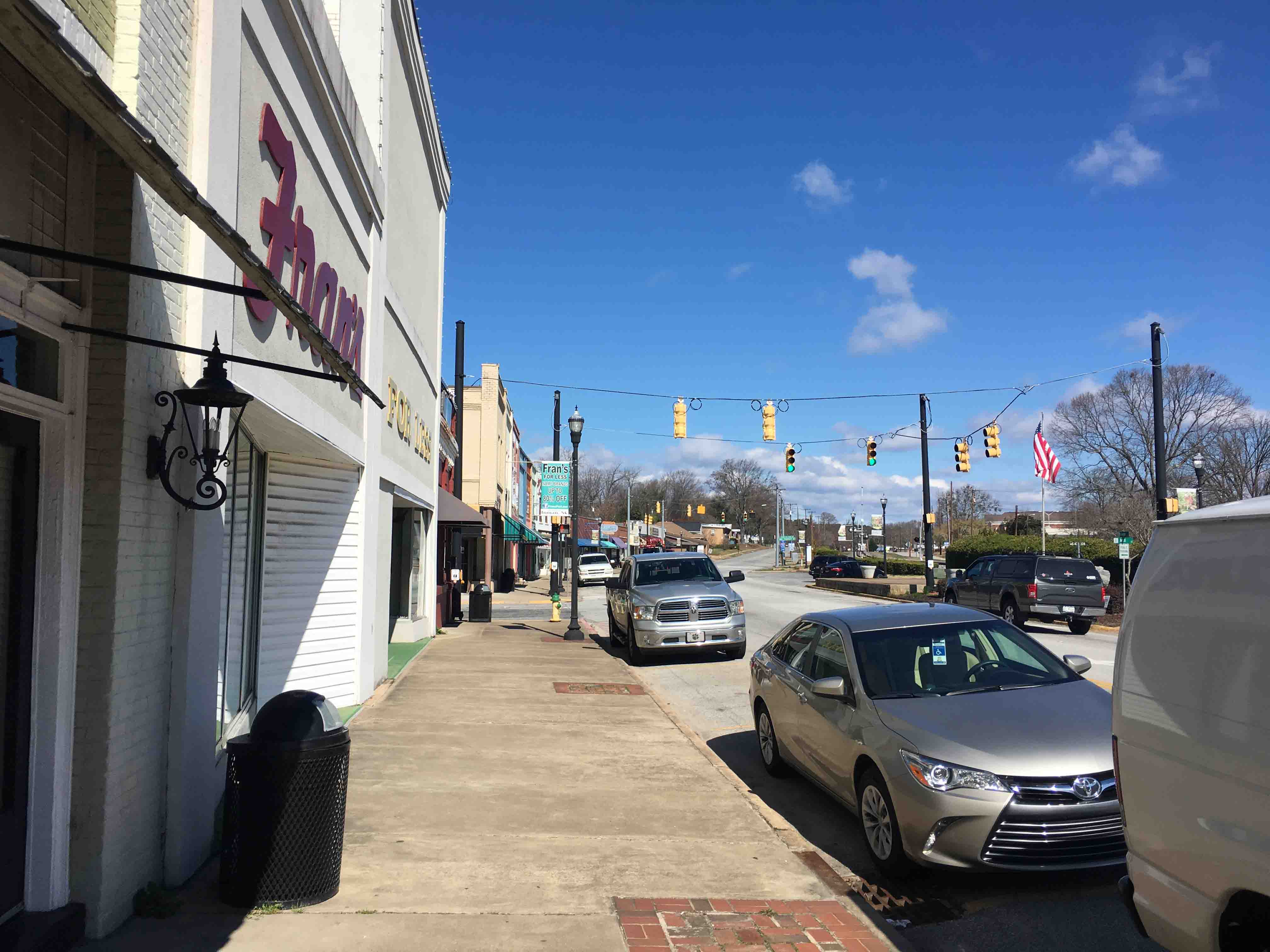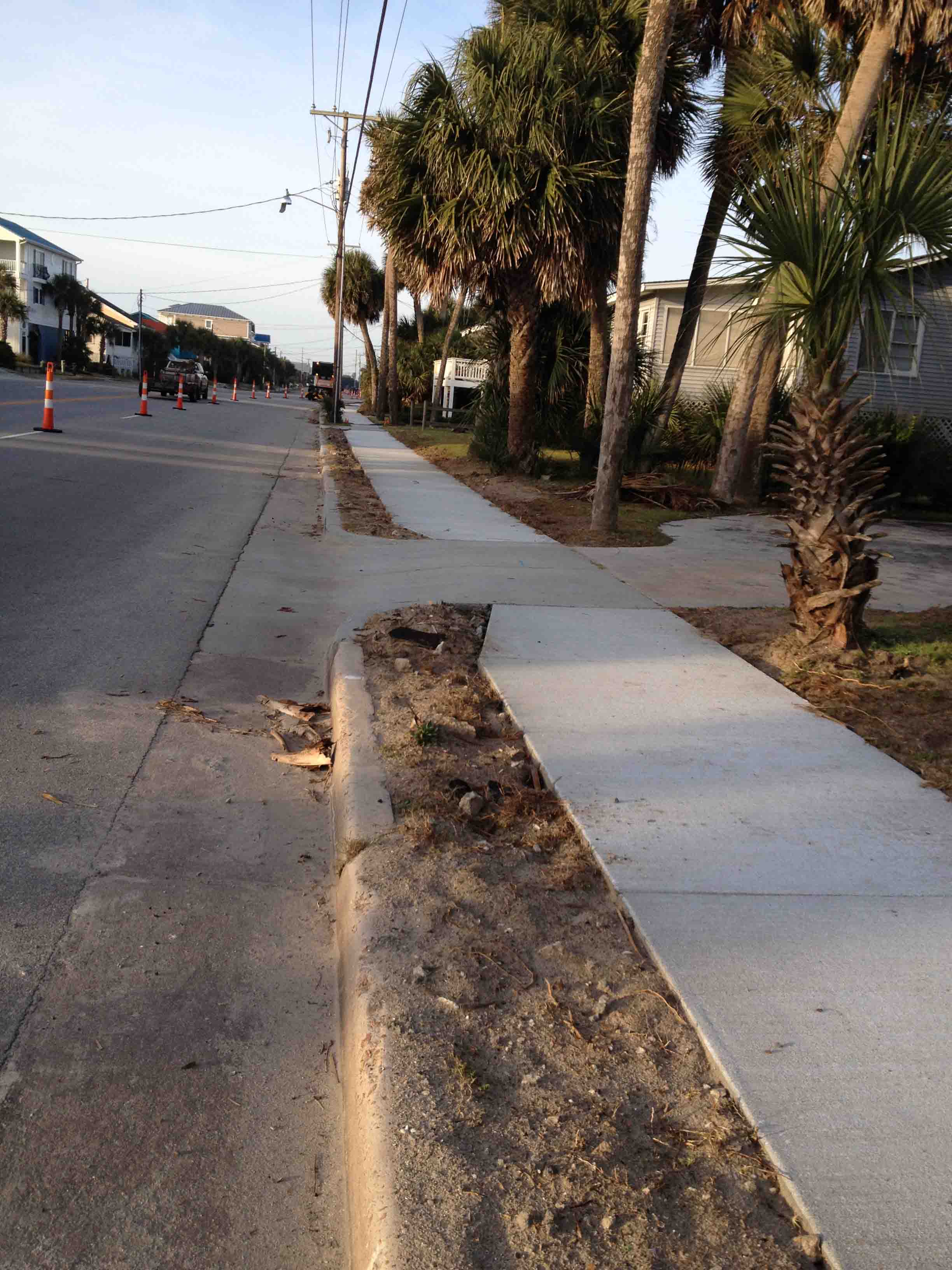The difference will be immediate. And silent.
There will be no sound of metal grazing concrete as you open the passenger-side door when parallel parked on a downtown street in Inman. The car door will not bump into the sidewalk — It will open fully and with no trouble.

The City of Inman will replace old sidewalks on its Main Street as part of extensive
improvements to downtown aesthetics. Photo: City of Inman.
This immediate difference — simple yet noticeable — is one of the goals of Inman's streetscape plan. It includes regrading an asphalt peak in the middle of a major downtown street that built up over years of repavings and now forces parked-car passenger doors to open downward toward the curb. That regrading is just one piece of the city's $1 million sidewalk and streetscape project to be completed this fall.
City officials can't force people to visit the downtown or instruct businesses to set up shop there, says Inman City Administrator Jeremy Caudle. But local government can do a lot of coaxing — and ensuring that residents have pleasant interactions with streets and sidewalks is part of that.
So the city is using funding from a Community Development Block Grant and the Appalachian Regional Commission to improve the sidewalks, gutters, curbs, crosswalk markings, drainage and driveways inside the city.
"We actually have a pretty good sidewalk system in Inman," said Caudle. "But the way something looks, the aesthetic of your built environment, is going to entice people to get out and walk around and frequent a shop. And it'll make it more enticing for a business owner to say, 'Hey, city hall is taking investment in the downtown seriously. It might be worth it for me to open up a shop here.'"
In the City of Marion, curb appeal is also on the mind of city leaders. Sidewalks, though right underfoot, make up fundamental infrastructure that affects everything from economic investment to placemaking and walkability.
"If you've got an industry riding through town, they look at things like that and think that if we can't keep the town clean, why would they want to come here?" said Marion Mayor Ashley Brady.
'Safe connectivity'
Inman's push to make pedestrian spaces appealing ties into a broader idea to link together a park, a school, a renovated mill and other spots around the city. The plans also include eight "conversation areas" scattered across the downtown — each spanning one or two parallel parking spots, complete with benches and trash cans.
Similarly, in the Town of Edisto Beach, a $1.7 million sidewalk project draws together the local map. The profound impact the new sidewalks had on quality of life also netted Edisto Beach an Achievement Award from the Municipal Association in 2016.

The Town of Edisto Beach sidewalk improvement project helped connect the
commercial district to the beach. Photo: Town of Edisto Beach.
"Sidewalks are critical in providing safe connectivity to the beach and our commercial district," said Edisto Beach Town Manager Iris Hill. "Because the sidewalk parallels the Atlantic Ocean, this provides folks safe access to our grocery store and convenience station, promoting a healthier lifestyle and alleviating traffic congestion."
Like in Edisto Beach, safety also drives Inman's plans. The project includes improvements to pedestrian crosswalks, because as Caudle put it, "People want to feel safe."
That's true everywhere. And it applies to residents and visitors of all ability levels.
In Edisto Beach, officials knew they needed to fix the crumbling sidewalks, which were putting pedestrians in danger and weren't compatible with the Americans with Disabilities Act. To avoid the broken sidewalk, visitors and residents were walking in the street where they risked being hit.
In the Town of Brunson, Mayor Patricia Williams said the town undertook sidewalk upgrades, in part, to make sure the surfaces were smooth enough for residents and visitors who travel by wheelchair and for the very young and the very old.
Community relations
Being sensitive to resident perceptions about work affecting public spaces is always a sound practice. And sidewalk work is no exception.
The City of Marion suffered extensive sidewalk damage from Hurricane Matthew in October 2016.
"We had big oak trees that had popped up," said Brady, adding that the SC Department of Transportation fixed the sidewalks after the storm. The city also received county transportation committee funds to address sidewalks that had long-standing maintenance needs.
Regular wear and a lapse in edging had also taken its toll on the sidewalks in Marion.
Sidewalks in Marion are 3 feet wide. But they were so overgrown with grass that there was only a narrow footpath down the center of the sidewalks. Something had to be done.
"We've got an edger, so we just started hitting street after street and edging sidewalks and curbing," said Brady, adding that city employees spaced the improvements out across various city quadrants to make sure that one area didn't see all the improvements at one time, while another quadrant sat untouched.
"We'd do work on this one and then bounce over to this other one," he said. "We want to make sure we're being fair to everybody. You've got a curb that's overgrown, grass all in the gutter, and then the next thing you know, it's nice and pretty. It does make a world of difference."
In the City of Inman, Caudle said city officials were sensitive to the temporary disruption the sidewalk improvements would create for downtown businesses.
"Many of the downtown merchants with whom I've spoken understand it's going to be a headache as we're working on the sidewalks and an inconvenience for a short while," said Caudle. "But most see the benefit it's going to have to the city and the value it will have to their business."
